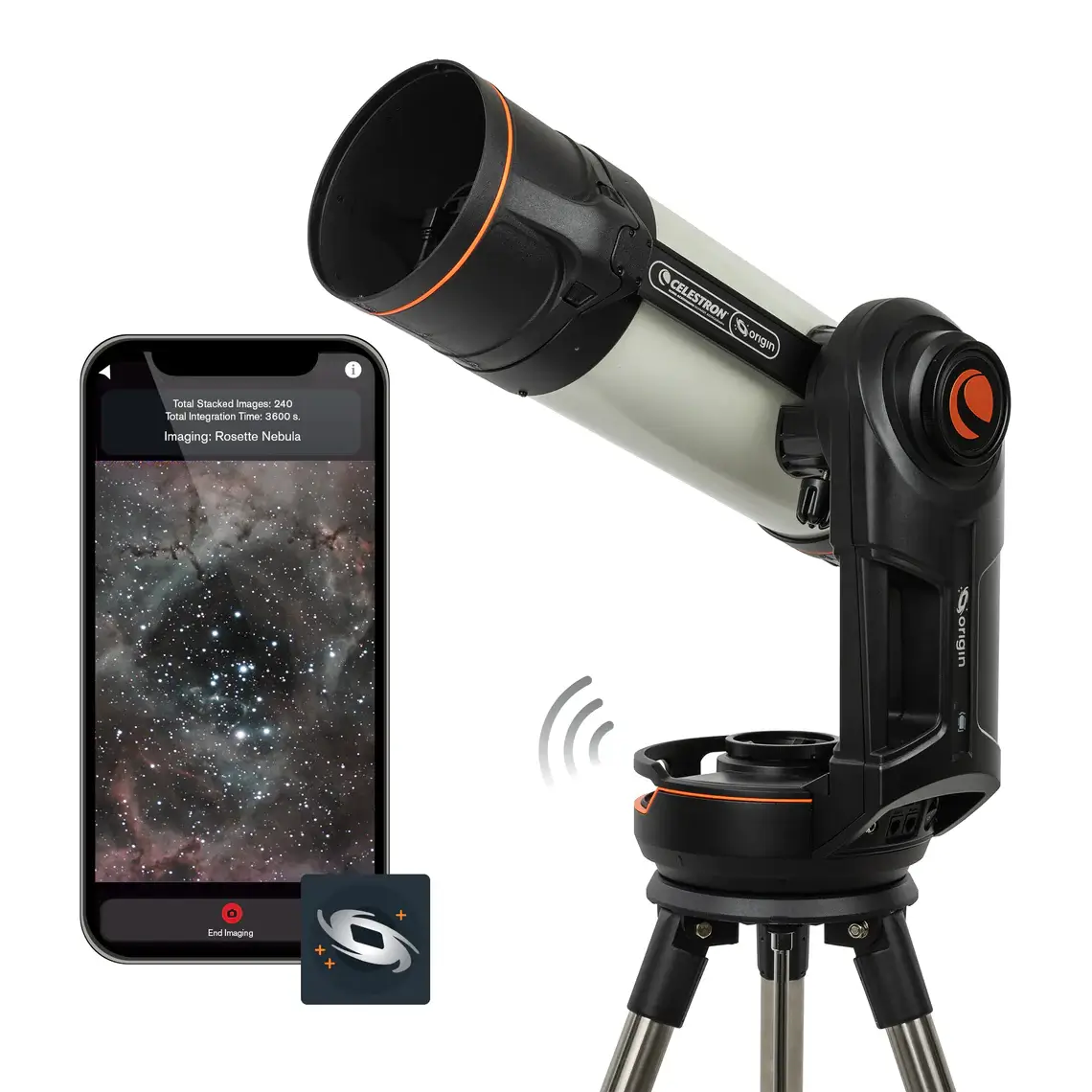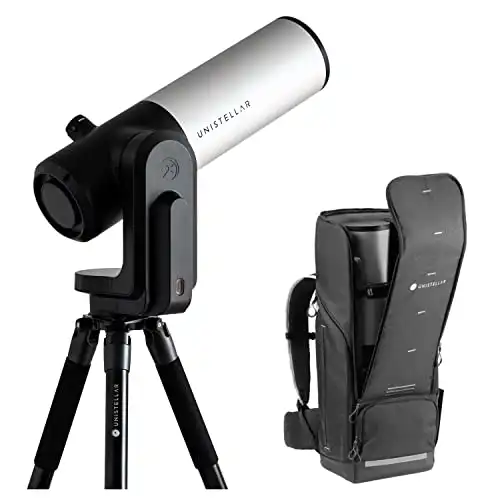Celestron Origin vs Unistellar eVscope 2: 10 Second Summary
- The Celestron Origin is a superior astrophotography telescope to the Unistellar eVscope 2.
- It is cheaper, but is about twice as heavy and lacks an eyepiece.
- The main selling point of the Unistellar eVscope 2 is the eyepiece which means you can view through the telescope and not just on a screen.
- It has lower telescope specs, but the camera resolution is higher, with Unistellar models the UX is seamless, and you can join Citizen Astronomy initiatives.
Why choose the Celestron Origin over the Unistellar eVscope 2?
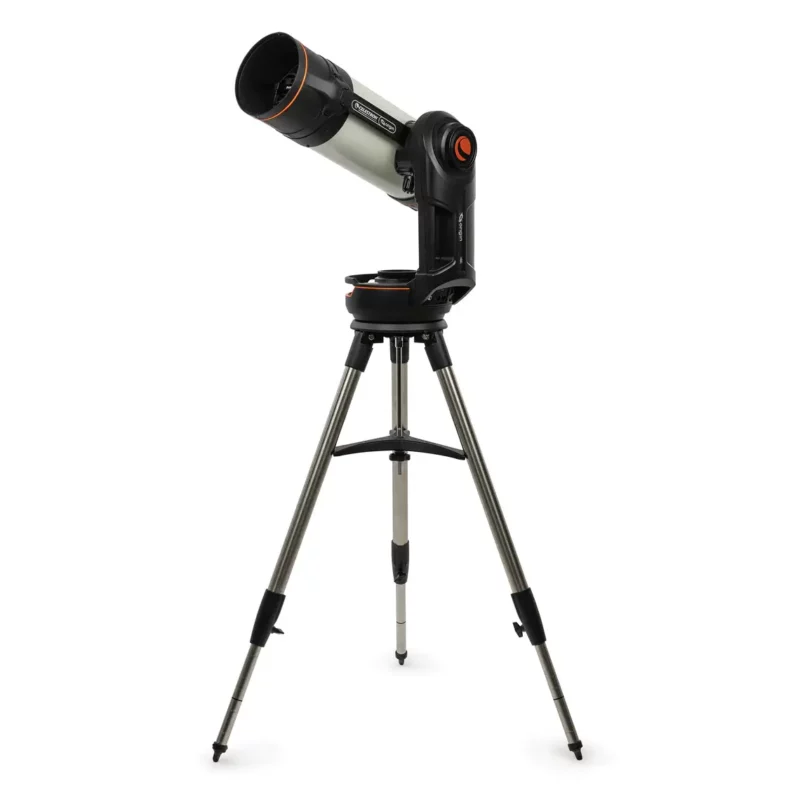
The Celestron Origin is a premium smart telescope from American astronomy manufacturer Celestron that was released in 2024.
It is Celestron’s first smart telescope and offers the highest specification Optical Tube Assembly (OTA – the telecope) of any smart telescope on the market.
In comparison to the Unistellar eVscope 2:
- The Origin telescope type is a specialist astrophotography type called a Rowe-Ackermann Schmidt Astrograph (RASA) that is well-loved and proven by experienced astrophotographers.
- The telescope has 6-inch aperture and an f/2.2 focal ratio – this is above that of the eVscope 2 and so the views and images are superior.
- The Origin comes with a full-height tripod and mount. Unlike the eVscope 2 (or any other smart telescope), the mount and camera can be replaced and upgraded in the future.
- The Origin is the best smart telescope for actual astrophotography and is effectively an off-the-shelf astrophotography setup with telescope, mount, camera and necessary accessories in an easy to use package.
The main downside is the size and weight of the package. At 40+ lbs it is roughly double that of the eVscope 2.
It is in the premium price bracket at $3,999, but this is cheaper than the eVscope 2.
Why choose the Unistellar eVscope 2 over the Celestron Origin?
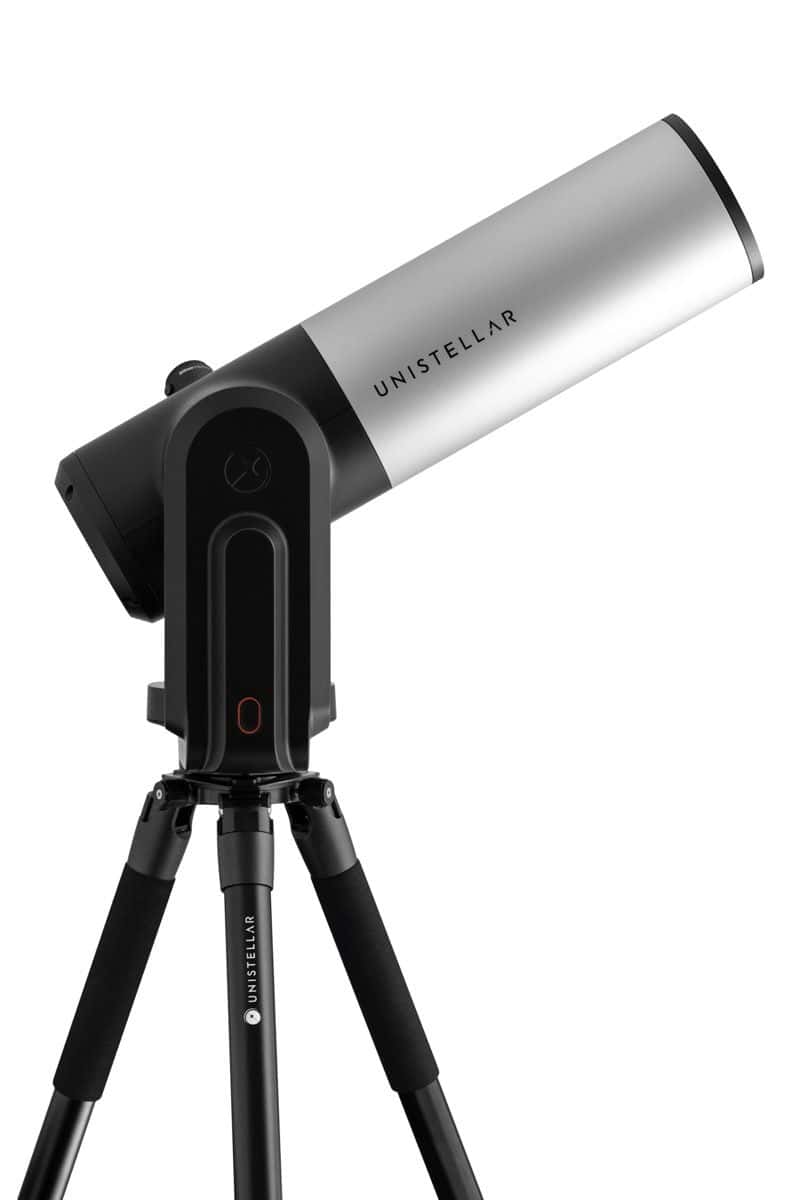
The Unistellar eVscope 2 is a premium smart telescope from French manufacturer Unistellar that was released in 2022:
- Its main selling point to differentiate it from the Origin (or any other smart telescope bar the Odyssey Pro) is its real-time viewing eyepiece. This means you can look through the telescope, rather than just view images on your smartphone or other screen. This is particularly good if using with friends or family as you have a more shared experience in taking turns to look through.
- Its telescope and camera specifications are very good – with a better camera than the Origin – and the user experience is slick and seamless.
- With all Unistellar models you can take part in Citizen Astronomy initiatives and join missions to track asteroids and hunt exoplanets.
The eVscope 2 may require collimation (a form of manual adjustment), unlike the Odyssey and Odyssey Pro. The Celestron’s RASA OTA may also require collimation.
However, the eVscope 2 is the most expensive of any smart telescope. This is the price of the eyepiece.
You may favor the eVscope 2 versus the Celestron Origin if:
- You would value the addition of the eyepiece
- You want a premium smart telescope with great ease-of-use
- You would enjoy the Citizen Astronomy features
- Would prefer the lighter weight and smaller size
- Are less motivated by the more advanced astrophotography capabilities of the Celestron Origin
- Have the additional budget
Telescope Specifications
The Celestron Origin has:
- 152mm (6 inch) aperture
- 335mm focal length
- f/2.2 focal ratio
- 1.27° x 0.85° field of view
The Unistellar eVscope 2 has:
- 114mm (4.5 inch) aperture
- 450mm focal length
- f/3.9 focal ratio
- 0.57° x 0.76° field of view
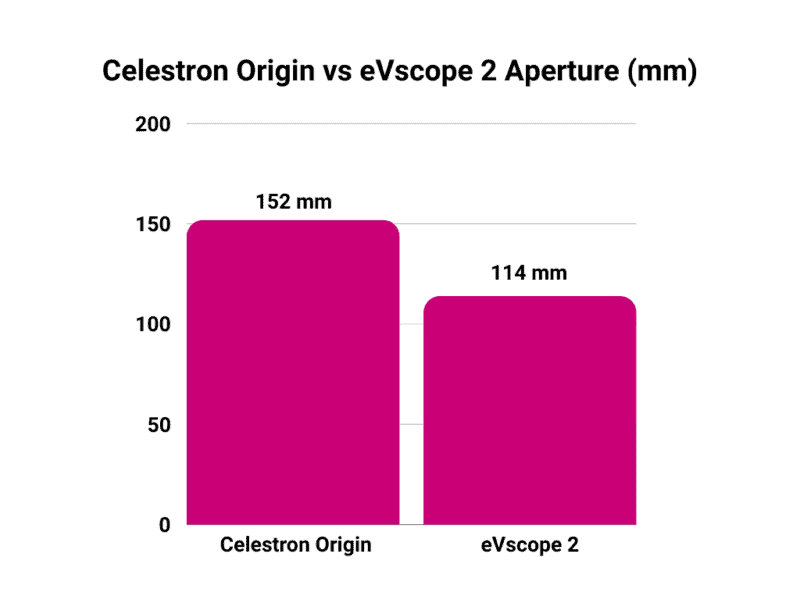
Camera Specifications
The Celestron Origin has a 6.4MP resolution camera of 3096 x 2080 size using a Sony IMX178 sensor and a pixel size of 2.4μm.
The Unistellar eVscope 2 has a 7.7MP resolution camera of 3200 x 2400 size using a Sony IMX347 sensor and a pixel size of 2.9μm.
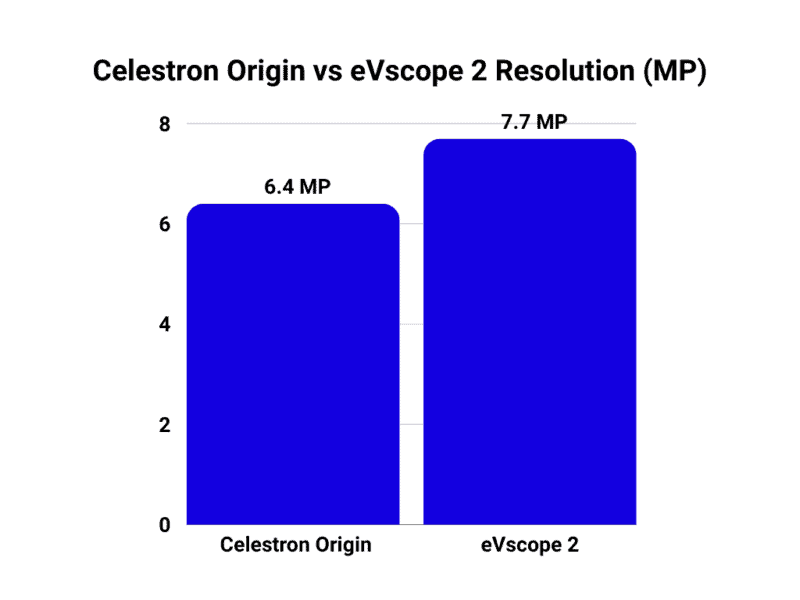
Size and Weight
The Celestron Origin weighs 18.9kg (41.6 lb) and has dimensions of 122 x 66 x 61 ((H x W x L in cm).
The Unistellar eVscope 2 weighs 8.9kg (19.8 lb) and has dimensions of 23 x 19 x 65 ((H x W x L in cm).
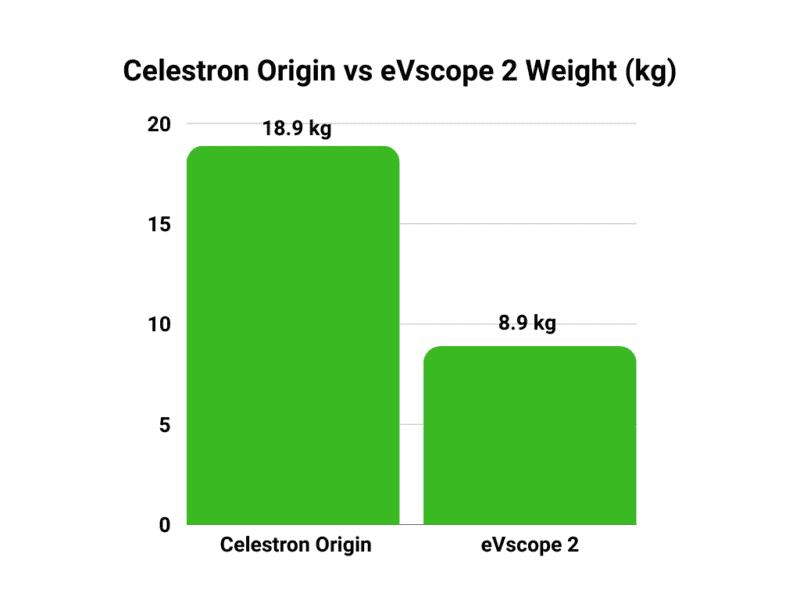
Price and Value for Money
The Celestron Origin costs $3,999, and the Unistellar eVscope 2 costs $4,899.
Note, these may vary so check the links to compare retailers if thinking about buying.
Specifications
| Celestron Origin | Unistellar eVscope 2 | |
|---|---|---|
| Year | 2024 | 2022 |
| Aperture | 152mm (6 inch) | 114mm (4.5 inch) |
| Focal Length | 335mm | 450mm |
| Focal Ratio | f/2.2 | f/3.9 |
| Limiting Magnitude | 13.61 | 12.98 |
| OTA type | Rowe-Ackermann Schmidt Astrograph | Reflector |
| Eyepiece | No | Yes |
| Field of View | 1.27° x 0.85° | 0.57° x 0.76° |
| Resolution | 6.4MP | 7.7MP |
| Sensor Size | 3096 x 2080 | 3200 x 2400 |
| Sensor | Sony IMX178 | Sony IMX347 |
| Pixel Size | 2.4μm | 2.9μm |
| Image Formats | Raw | FITS, TIFF, PNG, JPEG |
| Mosaic Mode | No | No |
| Size (H x W x L) cm | 122 x 66 x 61 | 23 x 19 x 65 |
| Weight | 18.9kg (41.6 lb) | 8.9kg (19.8 lb) |
| Mount | Included | Included |
| Tripod | Included | Included |
| Battery Life | 6 hrs | 9 hrs |
| Internal Storage | unknown | 64GB |
| Dew Control | Built-in | None |
| Retail Price* | $3,999 | $4,899 |
Celestron Origin vs Unistellar eVscope 2 Verdict
The Celestron Origin is right for you if you are looking for the best option in terms of actual astrophotography and are ok with the additional weight and reduced portability.
The eVscope 2 is a best for you if you want the additional experience that comes with the eyepiece and would more value taking part in the Citizen Astronomy activities over advanced astrophotography.
|
$4,299.00
|
$5,199.00
|



